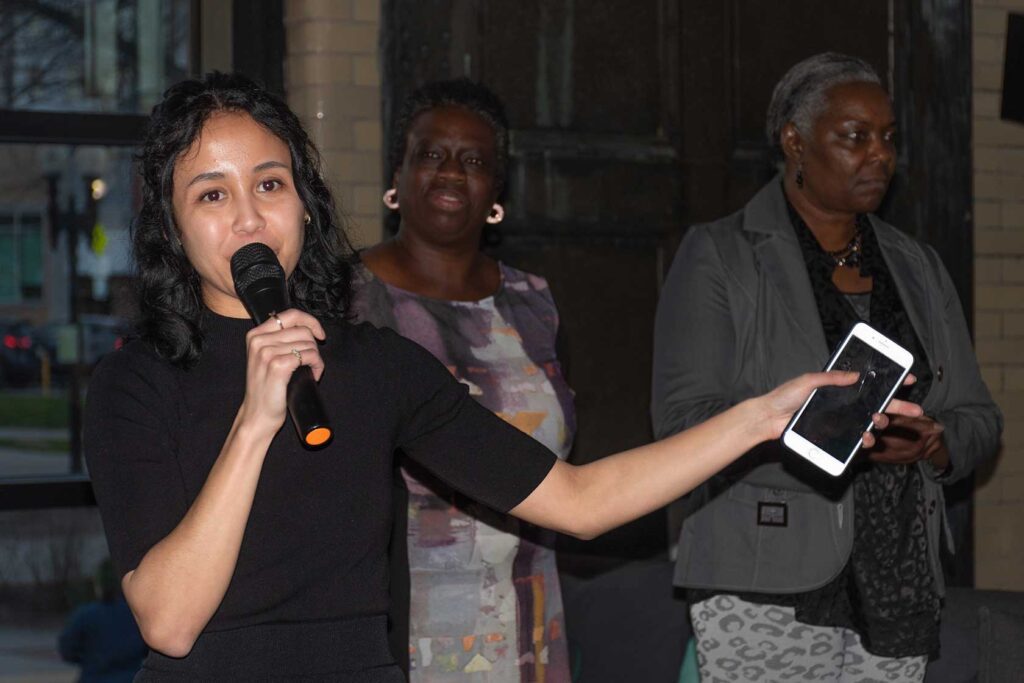
Under the dappled amber glow of sunlight streaming through the towering window of the Substation workspace in Roslindale, community members filed through a maze of framed pictures.
The display wasn’t that of a traditional art gallery, however. Instead, the photos showed personal care products, the people who use them and, most importantly, hair, to bring focus to cosmetic products and the chemicals that are in them.
The RESTYLE — Retail Environment and Hair Styling Exposure Study — community art show on April 25 was the latest part of a series of research efforts from Marissa Chan, a Harvard T.H. Chan School of Public Health Ph.D. candidate, around accessibility of healthy hair care products for Black communities, what she terms “beauty justice.”
Her work is focused on identifying what barriers are limiting purchase of safer products, she said.
“We know enough to know who is impacted by this issue of unsafe or dangerous chemicals in personal care products and specifically hair products, but what can we do about it?” Chan asked.
Chan previously authored a study, published in the journal Environmental Health Perspectives in September, that found stores in low-income and predominantly Black neighborhoods in Boston were more likely to sell hair care products with potentially harmful chemicals than stores in more affluent communities.
Black community members, and Black women in particular, often face pressures to wash, condition and straighten their hair using products that may not always be good for them.
There has been some pushback on the potentially harmful chemicals — last fall, the U.S. Food and Drug Administration proposed a ban of chemical hair straighteners that contain formaldehyde, a known carcinogen; and at the 2023 NAACP convention, delegates adopted a resolution to bring more awareness about the link between hair products and cancer — but barriers still persist.
Community members whose voices were featured in the RESTYLE show said their engagement helped them better understand what’s in hair care and other personal care products.
“If we’re going to take care of our physical body, it has to be more than the food that we place in our mouth. It has to also be the things that we use on our own self, if we’re looking at total health care,” said Talya Jones, a Somerville resident and co-researcher — what Chan termed the participants — in the RESTYLE project.

Community members learn about the potential impact of chemicals in hair care products at the RESTYLE Community Art Show, April 25. The show, held at the Substation in Roslindale, was part of community-focused research by Harvard public health PhD candidate Marissa Chan, into barriers to access of safer hair care products. BANNER PHOTO
Jones said that, as a result of her engagement with the research, she’s started looking at and considering the ingredients labels when she buys products.
There are often misconceptions about how safe a product is, said Tamarra James-Todd, an associate professor of environmental reproductive epidemiology at the Harvard School of Public Health.
“What the average person doesn’t know is that these products contain multiple forms of harmful chemicals,” said James-Todd, who serves as Chan’s dissertation advisor. “I think that the average person thinks, ‘Oh, it’s on the shelf and it must be safe for me.’”
But that isn’t always the case. The FDA, which has an approval process for medications in the United States, does not approve cosmetics products, though it has some regulations for how they are branded and labeled.
Other barriers limit clear information about what’s in personal care products, including physical ones. Community members who participated in the research described plexiglass barriers in stores or other anti-theft measures as factors that can limit understanding of what’s in a product.
Linda McRae, a North Attleborough resident who participated in the project, said she came across a product with an anti-theft sensor covering the ingredients list, making it impossible to see what was in the product.
Even when those lists are visible, long and complex names for chemicals can keep consumers in the dark.
“Your average person is not a chemist,” James-Todd said.
Much of the concern raised in Chan’s work focuses on endocrine-disrupting chemicals, substances that act like hormones in humans and can affect bodily processes.
Those impacts tend to be especially prominent among younger, growing children or pregnant individuals, said Kimberly Parra, a postdoctoral researcher at Harvard’s public health school.
Parra does separate but adjacent work to that of Chan’s RESTYLE project, focusing often on the impacts of chemicals on pregnancy.
She said the specific impacts of endocrine disruptors and other chemicals in personal care products can be hard to imagine, since the effects can be hard to identify on their own.
“Sometimes when we don’t see it, it can be hard to imagine what it might do to our body,” Parra said.
But that doesn’t mean the effects aren’t there. Exposure to endocrine disruptors has been linked to preterm labor and early puberty, especially in women.
Non-traditional structures for sharing information on the topic, like that of Chan’s RESTYLE art show, can be important to raise community awareness of the issue and the impact of the chemicals, Parra said.
The qualitative data — descriptions and observations, rather than numbers and statistics — in the art show was rooted in community engagement. Chan called the community members who contributed observations about hair products “co-researchers” rather than “participants” to reflect how they not only provided the information featured in the show, but also helped shape the process and outcome.
She said that impact on the project was outsized — guiding the selection of a number of themes focused on in the show — and that the event was really about them.

Tamarra James-Todd (right), an associate professor of environmental reproductive epidemiology at the Harvard T.H. Chan School of Public Health, speaks to attendees at the RESTYLE Community Art Show at the Substation in Roslindale, April 25. The show was part of research by PhD candidate Marissa Chan’s (left) dissertation on accessibility of safe hair care products for Black communities. BANNER PHOTO
That kind of community focus isn’t present in environmental health research as often as it should be, James-Todd said.
“You don’t typically do environmental health in a way that fully engages with communities. Qualitative research is not something that is really incorporated into our field as well,” she said. “She’s provided an opportunity to really listen to people’s stories.”
That input can be important for shaping impactful outcomes.
“I think that it’s recognizing that the solutions are multi-level, and that the solutions can’t just come from scientists,” James-Todd said. “The most effective solutions, the most powerful solutions are going to come from those that are impacted.”
The work is on-going. Following the event, Chan is collecting survey data about attendee reactions to the art show and thoughts on potential solutions to the gaps in equitable access to safer hair care products as another branch of the research.
Following up on her September paper, Chan has also expanded data around the availability of hair products by potential health impact and neighborhood. Initially, that research looked at the availability of personal care products in eight neighborhoods in Boston, but Chan said she and other researchers have expanded their database to all of the city’s neighborhoods.
Her September study found disparities in easy access to healthier hair care products. She said the next step she wants to pursue is to investigate why those gaps appear, with historic redlining being one consideration to answer that question.
That paper will attempt to evaluate if communities in Boston are facing retailer redlining — underrepresenting or not serving certain communities based on demographics — something Chan said has been considered for food deserts and pharmacy access, but not hair care products.
All the work is part of her dissertation, and though she expects to graduate in November, she said she hopes to continue with work on the topic in the future. She said that, through her work, her community co-researchers seemed eager to continue the work too.
“It’s not going to end with this,” Chan said. “Basically, all of the co-researchers during our last conversation were like, ‘Marissa, what’s next?’ So, I’m excited that I have the chance and the enthusiasm from the community to keep on doing this work.”






